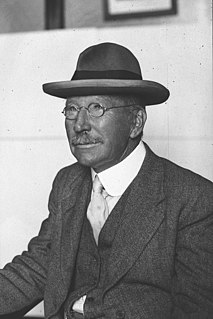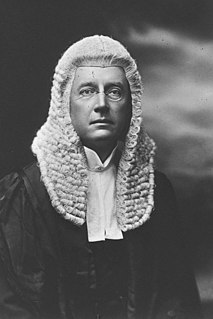Related Research Articles

David Robert Hall was a politician and lawyer in New South Wales, Australia.
South Sydney was an electoral district for the Legislative Assembly in the Australian state of New South Wales from 1880 to 1894, covering the southern part of the current Sydney central business district, Haymarket, Surry Hills, Moore Park and Chippendale, bordered by George Street, Broadway, City Road, Cleveland Street, South Dowling Street, Dacey Avenue, the western edge of Centennial Park, Moore Park Road, South Dowling Street, Oxford Street and Liverpool Street. It elected four members simultaneously, with voters casting four votes and the first four candidates being elected. For the 1894 election, it was replaced by the single-member electorates of Sydney-Phillip, Sydney-Belmore, Sydney-Flinders and Sydney-Cook.
Belmore was an electoral district of the Legislative Assembly in the Australian state of New South Wales, created in 1904 in inner Sydney from Sydney-Belmore and parts of the abolished seats of Sydney-Cook and Sydney-Phillip. It was named after Governor Belmore. It was originally in northern Surry Hills bounded by George Street and the Darling Harbour railway line in the west, Cleveland Street in the south, Liverpool Street, Oxford Street in the north and Riley Street, Wilton Street and Waterloo streets in the east. In 1913 it absorbed part of the abolished seat of Pyrmont. In 1920, with the introduction of proportional representation, it was absorbed into the multi-member electorate of Sydney.

Arthur Hill Griffith was a politician, teacher and patent attorney in New South Wales, Australia. He was a member of the New South Wales Legislative Assembly from 1894 until 1917 and held a number of ministerial positions in the Government of New South Wales. He was a member of the Labor Party.
×

Elizabeth Lilian Maud Fowler MBE, JP was an Australian politician. She was Australia's first female mayor, serving as mayor of Newtown, New South Wales, from 1937 to 1939. She later represented the seat of Newtown in the New South Wales Legislative Assembly from 1944 to 1950. She had a long involvement with the Lang Labor faction of the Australian Labor Party (ALP), which had evolved into a separate party by the time of her election to parliament.
Members of the New South Wales Legislative Assembly who served in the 25th parliament of New South Wales held their seats from 1920 to 1922. They were elected at the 1920 state election on 20 March 1920. The Speaker was Daniel Levy with the exception of 13–20 December 1921 when he was replaced by Simon Hickey.
The Protestant Labour Party, alternatively spelt Protestant Labor, was a minor Australian political party that operated mainly in New South Wales, Queensland and South Australia in the 1920s and 1930s. It was formed by Walter Skelton in July 1923 as the Protestant Independent Labour Party. who had stood for the New South Wales Legislative Assembly district of Newcastle at the 1922 election, campaigning as a Protestant Independent Labour candidate, in which he was elected first of five members, receiving 25.19% of the vote. In 1925 he was re-elected to the Assembly under the Protestant Labour label, as the second of five members, receiving 17.70% of the vote. The party stood candidates in 12 of the 24 districts however Skelton was the only one elected, with the next highest candidate receiving 5.10% of the district vote.
Abram "Abe" Landa was an Australian politician and a member of the New South Wales Legislative Assembly from 1930 until 1932 and from 1941 until 1965. He was variously a member of the Australian Labor Party (NSW) and the Australian Labor Party. He held a number of ministerial positions between 1953 and 1965.
Roger Bede Nott was an Australian politician and a member of the New South Wales Legislative Assembly from 1941 until 1961. He was a member of the Labor Party and held numerous ministerial positions between 1954 and 1961. He was the Administrator of the Northern Territory between 1961 and 1964.

Thomas John Shannon was an Australian real estate agent, alderman and state politician. He was a member of the New South Wales Legislative Assembly from 1927 until his death. He was variously a member of the Labor Party(ALP) and the Australian Labor Party (NSW).
Thomas George Rusden was a squatter and politician in colonial New South Wales. He was a member of the Legislative Council between 1855 and 1856 and a member of the Legislative Assembly for one term between 1856 and 1857.

The McGowen ministry was the 34th ministry of the New South Wales Government, and was led by the 18th Premier, James McGowen. This ministry marks the first Labor ministry in the state of New South Wales.
This is a list of members of the New South Wales Legislative Council from 1843 to 1851. The 1843 Electoral Act prescribed 36 members, 24 to be elected, 6 appointed by virtue of their office and 6 nominated. The appointments and elections were for five year terms and thus occurred in 1843,</ref> and 1848. The Speaker was Alexander Macleay until 19 May 1846 and then Charles Nicholson. The parliament was dissolved on 30 June 1851 as a result of the 1851 Electoral Act which increased the number of members in the Council to 54.

John Garland was a Scottish-born Australian politician.
Members of the New South Wales Legislative Council who served from 1913 to 1917 were appointed for life by the Governor on the advice of the Premier. This list includes members between the election on 6 December 1913 and the election on 24 March 1917. The President was Sir Francis Suttor until his death in April 1915 and then Fred Flowers.</ref>
Phillip, an electoral district of the Legislative Assembly in the Australian state of New South Wales, had two incarnations, from 1904 to 1920 and from 1927 to 1981.
Surry Hills, an electoral district of the Legislative Assembly in the Australian state of New South Wales had two incarnations, from 1904 until 1920 and from 1927 until 1930.
A by-election was held for the New South Wales Legislative Assembly electorate of Paddington on 24 May 1919 because of the resignation of John Osborne (Labor) who had accepted an appointment to the Metropolitan Meat Industry Board. The board was responsible for the control and maintenance of abattoirs, cattle sale yards, meat markets, and slaughterhouses in the greater Sydney region. H. V. Evatt described the appointment as intended to deprive Labor of one of its better political organisers ahead of the 1920 election.
A referendum concerning the reform of the New South Wales Legislative Council was put to New South Wales voters on 13 May 1933 and was passed by the voters with a margin of 2.94%. The text of the question was:
Do you approve of the Bill entitled "A Bill to reform the constitution and alter the Powers of the Legislative Council; to reduce and limit the number of Members of the Legislative Council; to reconstitute the Legislative Council in accordance with the reformed constitution; to amend the Constitution Act, 1902, and certain other Acts; and for purposes connected therewith."
References
- 1 2 "Mr Thomas John Shannon (1884-1954)". Former Members of the Parliament of New South Wales . Retrieved 23 March 2021.
- ↑ "Writ of election: Phillip". Government Gazette of the State of New South Wales . No. 107. 15 July 1954. p. 2059. Retrieved 23 March 2021– via Trove.
- ↑ "Two contest Phillip by-election". The Sydney Morning Herald . 23 July 1954. p. 5. Retrieved 23 March 2021– via Trove.
- ↑ "Patrick Darcy Hills". Sydney's Aldermen. City of Sydney. Retrieved 23 March 2021.
- ↑ Green, Antony. "1954 Phillip by-election". New South Wales Election Results 1856-2007. Parliament of New South Wales . Retrieved 23 March 2021.